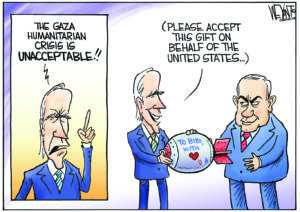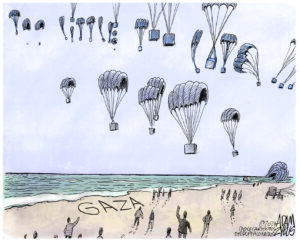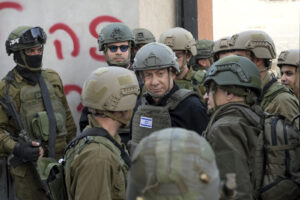VIDEO: Chris Hedges and Max Blumenthal on Israel, Gaza and ‘The 51 Day War’
In an interview on teleSUR's "Days of Revolt," Chris Hedges and Max Blumenthal discuss the brutal tactics used by the Israeli state in its ongoing effort to suppress Palestinian resistance in the Gaza Strip.In an interview on teleSUR’s “Days of Revolt,” Chris Hedges and Max Blumenthal discuss the brutal tactics used by the Israeli state in its ongoing effort to suppress Palestinian resistance in the Gaza Strip.
A transcript of the exchange provided by The Real News Network appears below.
— Posted by Alexander Reed Kelly.
CHRIS HEDGES: Hi, I’m Chris Hedges. Welcome to Days of Revolt. Today we’re going to discuss Israeli military policy. In particular, how that policy is directed towards the subject population in the Gaza Strip; 1.8 million Palestinians trapped in the largest open-air prison in the world. We’re going to focus on the assault last summer that left over 2,000 dead, including over 500 children; what that means for where Israel is going to go; and what that means for the Palestinians themselves.
In the studio with me is Max Blumenthal, the author of The 51 Day War, as well as Goliath, which without question I think is the most important book on modern-day Israel. Thank you, Max.
MAX BLUMENTHAL: Thanks for having me.
HEDGES: So, so we’ve seen, going back to 2006, a series of very heavy military strikes carried out by Israel against a completely captive population in Gaza. 2006 when they were attempting to free the Israeli soldier Shalit, 2007, 2008 and ’09 with Cast Lead, Pillar of Cloud, 2002, and last summer the most extensive assault on the Gaza Strip with Protective Edge. Why? Why does Israel keep using this kind of military force, and why do they keep ratcheting it up?
BLUMENTHAL: Well, it’s fairly simple if you consider that the Gaza Strip has really been the base of the Palestinian armed struggle since the 1950s, and that Palestinians in the Gaza Strip have not relented in their quest to liberate themselves. They’ve chosen to use arms as one method. Since the Israeli disengagement from Gaza in 2005 when several thousand fanatical settlers were pulled out by Israeli forces and the Gaza Strip was occupied through the panopticon model, in other words occupied from without, placed under siege, the attacks on the Gaza Strip have grown more intense as the military, the armed factions in the Gaza Strip underwent a process of militarization of their own in which they shifted from attacks on soft Israeli targets to–.
HEDGES: You’re talking about, like, suicide bombings.
BLUMENTHAL: Like the suicide bombing, for example. It was completely scrapped after 2005. And through the Philadelphi Corridor in the southern city of Rafah, the al-Qassam brigades, the military wing of Hamas, and other armed factions were able to actually import the kind of weapons that any guerrilla army possesses.
HEDGES: Through tunnels.
BLUMENTHAL: Through tunnels. Mainly light weapons. You know, rocket-propelled grenades. And also they, they enhanced their production capacity of mortars and rockets, the rockets were able to reach longer distances to Jerusalem and Tel Aviv. And the point was to challenge the Israeli military directly, which built up to what we saw in Operation Protective Edge, especially in the battle of Shuja’iyya. Meanwhile the Israeli military adopted a doctrine which it named after a neighborhood in southern Beirut that it destroyed in the 2006 campaign–.
HEDGES: This is the Dahiya.
BLUMENTHAL: ?against Hezbollah, called the Dahiya doctrine. This is a neighborhood in southern Beirut, Dahiya, that was a base of support for Hezbollah. The neighborhood was completely destroyed by the Israeli air force. And it reflected the view of this operation to destroy this neighborhood, to attack the civilian population. Reflected the view of the Israeli military intelligence apparatus, which was that it was no–it was not going to be possible to militarily defeat and dislodge Hezbollah or Hamas, which was in control of the Gaza Strip since 2005, 2006. Therefore the civilian population had to be attacked in order to pressure it to give up support for the armed struggle. Support for armed resistance. And to be pacified as the Palestinians inside the West Bank have been under the authority of the–under the control of the Palestinian Authority.
So the Palestinian Authority in the West Bank coordinates with the Israeli military, and is basically a native subcontractor for the occupation.
HEDGES: Well, they carry out the security for–on behalf of Israel.
BLUMENTHAL: Exactly. And so–.
HEDGES: For which they receive a fair–which they’re paid.
BLUMENTHAL: So the Dahiya doctrine aims to, by attacking civilians, aims to demoralize the civilian population until they assent to the West Bank model. And the people in the Gaza Strip are incredibly resilient. They almost unanimously support resisting the occupation. Because they–and the siege. Because they see what Mahmoud Abbas, president of the Palestinian Authority has gotten in exchange for security coordination.
HEDGES: Right. Which is nothing.
BLUMENTHAL: Not only nothing. He’s gotten record settlement growth, the shrinking of the [gilded bantustans] he controls. Palestinians are being brutalized and raided in the–in, in the West Bank. About 25 have been killed this year. They don’t have to put up–they don’t have to put up with that in the Gaza Strip. What they do have to deal with is the Dahiya Doctrine, and what former Israeli army Chief of Staff Benny Gantz refers to as mowing the lawn. And this means applying the Dahiya Doctrine every few years in order to grind down the resistance. In other words, everyone in the Gaza Strip is a blade of grass, and they need to be brought down to size.
HEDGES: And by the Dahiya Doctrine, it is about the destruction, almost obliteration, of the Dahiya neighborhood–.
BLUMENTHAL: Yeah.
HEDGES: –in, in Beirut. Outside of Beirut.
BLUMENTHAL: So we’re, we’re talking about intentional attacks on the civilian base of political support for Hamas or Hezbollah, as well as an intentional program to spur long, long-term exhaustive reconstruction processes that can’t be comprehensively carried out. That was expressed in a paper produced in 2008 for the Institute for National Security Studies by former Israeli general Gabi Siboni called Disproportionate Force. And it directly calls for causing massive reconstruction processes.
HEDGES: But what you see going back to 2006 is that it’s not working. And in the incursion last summer you had 68 Israelis killed. Which is a high number in Israel. Most of them were killed were soldiers. They were killed by Hamas fighters inside Gaza. And we have Israeli officials, Livni, Avigdor Lieberman, and others talking about another strike being inevitable.
BLUMENTHAL: Right. I mean, the Dahiya Doctrine has failed in almost every respect, which is why the violence intensifies each time. So in 2008-2009, which was the first major assault on the Gaza Strip–.
HEDGES: This was the Cast Lead–.
BLUMENTHAL: Cast Lead. We saw one family in particular lose most of its members. The Sumuni family, I think, in Beit Hanoun. In this assault we saw over 50 families lose most or all members. I saw in Haaretz, the Israeli newspaper, a report that 81 families were erased from the civil registry in the Gaza Strip. The Israeli human rights group B’Tselem concluded that the Israeli military had adopted an open-fire policy that included targeting family homes. And if you understand how people live in the Gaza Strip, which is one of the most densely populated areas on earth, the homes are three to four, sometimes five stories high, and each story represents a generation of a family. So when it gets hit by a missile you see a family liquidated.
A reporter I spoke to who was in Gaza before I was able to get permission to enter visited the home of the [Batch] family. The father of the family was the head of the police department in Gaza City, so he was targeted, the Israeli military, they love to kill cops. They consider cops to be a military target, and so this is one of their cop-killing operations. But they knew his whole family was in the house with him. They aimed to surprise them of course, in order to eliminate their target. And when the reporter arrived he found that over 20 members of this family had been killed in one strike. He found fingers on the ground, and he said that limbs were hanging from the trees.
So this violence has intensified, and it also has, it reached sectors of Gazan society that had never been attacked before, like the educated middle class which lives in the soft heart of Gaza City. So not only were, was 20 percent of the entire are of the Gaza Strip reduced to rubble and the border areas, the areas bordering Israel which are fortified by the armed factions of the Gaza Strip. These are where the tunnels are, and so on. But we saw residential highrises in the center of Gaza City brought down towards the end of the war by a very frustrated Goliath unable to punish David into submission. And so Netanyahu’s approval rating, his approval ratings were flagging. The Israeli public wanted more violence. He ordered strikes on, for example, Zafer Four, which is a 14-story residential highrise inhabited mostly by people who support the rival of Hamas, Fatah. He attacked Basha Tower, which is the oldest residential, or the oldest civilian highrise in the Gaza Strip, largest one, and it’s home to the media. It’s as if, you know, a foreign army brought down the CNN tower in Atlanta. Or, you know, bombed us right now.
HEDGES: I want to ask a little bit about tactics. Because with the withdrawal of the Israeli settlers they’ve created this kind of free fire zone where they test weapons. But before I do, I want to ask about the disparity between what Israel says it does and what it does. Even if you go on the IDF, the Israeli Defense Force website, it goes on and on about how it protects civilians, it won’t target families. It cares about human rights. And yet the reality on the ground, and you and I have been on the ground, is really just indiscriminate, wholesale slaughter of primarily civilians, including children.
BLUMENTHAL: Yeah. I mean, the testimonies I gathered in the rubble were–described sadism and savagery that I had never heard of before.
HEDGES: Give me some examples of that.
BLUMENTHAL: I mean, we heard, we heard constantly about human shields.
HEDGES: Right. Which, we should be clear, were not being used by Hamas.
BLUMENTHAL: Right. And it also, it contravenes the ethos of the young men of the al-Qassam brigades. Their ethos is based on honor and bravery, and they would never put children in front of them when confronting Israeli soldiers. I mean, they pride themselves on confronting them directly and really daring operations.
And you can see those operations on video for the first time, like the [nal halaz] operation, where an al-Qassam team tunneled into an Israeli military base in Israeli territory with GoPro cameras attached to their helmets. Killed every soldier inside the base, took a Tavor rifle, and went back into the tunnel. I mean, this was a direct confrontation with the most powerful military in the Middle East, and they succeeded through the kind of cavalier attitude that they wanted to display and project to the outside world. I mean, this is important if you understand from a Palestinian perspective that most of what you’ve seen throughout your life, either directly or on YouTube videos or news reports, are Israeli soldiers humiliating Palestinians. So now the tables are turned.
Okay. But there was–the ability of the armed factions to protect civilians from Israeli savagery inside the Gaza Strip was very limited. So you had instances in eastern Rafah, for example, where the Israeli military advanced on July 26 on the Abu Said family home, during an Iftar. During Ramadan. Asked, does anyone speak Hebrew? The father answers in the affirmative. They shoot him in the chest and leave him to bleed to death. He miraculously survives. They send the family marching towards the city of Rafah. This is kind of a semi-rural area. And they take 19-year-old Mahmoud Abu Said into his home, strip him down, put him in a room with a muzzled dog, wrap him in a carpet. And then when they’re ready they take him out, stand him by the window, and shoot over his shoulders as they pick off his neighbors.
And I heard story after story of human shields in the border regions of the Gaza Strip. These are human shields being used by a very cowardly Israeli military to protect themselves. Another instance was the Wahadan family in Beit Hanoun who were ordered to stay in their house for a week as the Israeli military used it as a base of operations. And then when the military left they called in artillery strikes, destroying the entire neighborhood in an hour. And when I arrived there were still young men, this is weeks later, looking for the pieces of a two-year-old member of this family, [Rena] Wahadan, and her 52-year-old aunt, [Bagdad].
The town of Hosea, on the, in the–which is a very small farming town, right, located hard against the Israeli border, one of the first areas that Israeli soldiers took, was placed basically under siege for ten days. The Israelis declared it a closed military zone. The International Red Cross couldn’t get in. It’s during Ramadan, people are fasting. There’s no water, no electricity. The town is being completely destroyed. And there are 7,000 people trapped with Israeli soldiers honeycombed within the town. And so you hear stories about, like, the [Rajela] family attempting to escape, and leaving their daughter out on the road as they fall under attack from a tank division. The daughter, [Gadir], who’s 16, is severely handicapped and is severely physically disabled and unable to walk. She’s in a wheelchair, and so she’s left on the road in a wheelchair. And when the soldiers finally leave days later she’s found by her wheelchair on the road, alone, decomposing, riddled with bullets. Along with many other bodies.
Now, one of the few paramedics who was brave enough to attempt to get into this town of Hosea when it was under the closed military order was named [Mohammed Matar Abadla]. And actually when we did a talk in Princeton, one of his relatives spoke in the crowd.
HEDGES: Right. Right, was at the talk.
BLUMENTHAL: Yeah. I interviewed two of Abadla’s colleagues in Gaza City and they told me what happened on July 26, when they went in their ambulance for the Palestinian Red Crescent to retrieve a body that had been lashed to a tree by Israeli soldiers and shot in the leg. I don’t know if the person was alive or not. The Israeli soldiers told Abadla to get out of the ambulance. He’s the driver. Take a few steps forward. Hold a lighter over his head. And then they shot him in the chest and executed him. This happened on July 26. So I wanted to understand why this was happening, just as I wanted to understand why I heard so many testimonies of men who said they spoke Hebrew and were shot by Israeli soldiers.
HEDGES: Right, I was going to ask you about that.
BLUMENTHAL: Now, I wasn’t any, I wasn’t able to really determine why men were shot for speaking Hebrew except that perhaps they could have been seen as, you know, spies, or people who can translate and decode communications. Military communications. Israeli soldiers under their ethics code are given unlimited capacity to eliminate anyone who can be seen as a threat. So one thing they’re told they can do is kill someone who is holding a cell phone. We saw in the Goldstone report, the UN factfinding mission on Operation Cast Lead, cases of men who were holding cell phones who were killed. You know, you’re holding a cell phone so you’re seen possibly as doing command and control for the armed factions.
So I interviewed Col. Desmond Travers, who’s one of the four authors of the Goldstone report. He’s an expert in counterinsurgency, an Irish colonel. And he told me that one reason why the soldiers would ask Abadla to hold a lighter over his head is so they could say yeah, we killed him, but we thought he was holding a cell phone and giving orders, and calling in our location to armed factions in the area. So it was our mistake, but under the ethics code we’re authorized to kill anyone who could be seen as a threat.
HEDGES: But you did find that it was a pattern, to shoot, I think you said, older men who spoke Hebrew.
BLUMENTHAL: Yeah, I heard about cases in Hosea. Nasser Shamali is someone who was shot in Shuja’iyya after addressing soldiers in Hebrew.
HEDGES: Do you have an, any idea why?
BLUMENTHAL: And Dan Cohen, my colleague, actually tracked Shamali down, and he was shot in the arm, and the soldier thought he was dead. And we actually tracked him down and confirmed this. There are other–and I mentioned Mohammed Abu Said’s father in Rafah. So none of these people know each other, but they each described a similar situation. So the two theories are that one, these, the soldiers were frightened that these men could understand the orders they were giving to one another, and two, that these soldiers who were themselves raised under a regime of ethno-religious separation between Jewish Israelis and Palestinians are seeking to harden that regime by sending the message that you will not help us, we–and to send a message to an entire society that we don’t want any involvement between, with you and our societies. Don’t try to speak Hebrew to us. Don’t try to help us. Here’s what you get. Which is something that we’ve seen throughout, you know, colonial interactions with, you know, natives who attempted to be…
HEDGES: I want to ask you about the use of experimental weapons, which was true, I think, in Cast Lead, with DIME, which you wrote about. I believe you wrote about that in Goliath.
BLUMENTHAL: Yeah.
HEDGES: But talk a little bit about the experimental weapons. And then before we close, a little bit–because it’s not working. And because we have seen senior Israeli officials talk about further massive military assaults as inevitable, where we’re headed. But let’s talk about, just quickly about the, these horrific weapons that they’re testing. I mean, they’re using the people of Gaza like guinea pigs.
BLUMENTHAL: Well, since 2006 Israel has used dense inert metal explosives, which were designed actually by, you know, figures in Israeli academia, including quantum physicists, in collaboration with the Israeli military for assassinations. The point of these weapons is to generate enough–a massive explosive capacity, but within a limited range, to actually eliminate or limit civilian casualties to the target. I can’t explain how they, these weapons operate. They’re [inaud.].
HEDGES: They attack the soft tissue, right?
BLUMENTHAL: But they’re tungsten based, and they attack the soft tissue and cause death over a period of days. And the way that you identify the munitions is through a very small entry wound, and then massive burning of the organs. We’re talking about an entry wound that could be little more than one millimeter wide.
So I interviewed [Hani Shaniti], who’s a doctor, who’s in charge of documentation at al-Shifa Hospital in Gaza City, who told me of as many as 20 injuries he treated like this. Sometimes if they can treat the organs immediately or perform amputation the patient can be saved. But often the patient will just mysteriously die after a few days with very little exterior wounds or very little injury to the skeleton. Dr. Samir Homes, who treated victims at his dental clinic and OB-GYN clinic in central Rafah on Black Friday, August 4 in Rafah, after Israel threatened to bomb the main hospital, told me of these wounds, before that he had never seen them.
So this is an experimental weapon that’s been tested in the Gaza Strip over the course of the last eight or nine years. It’s very disturbing to hear about it. But then at the same time we see conventional weapons being tested. Like, for example, the Spike 4 missile which was used in the attack at the beginning of Operation Cast Lead in December 2008 on the police cadet graduation ceremony in Gaza City, where dozens of police cadets were killed, scores were wounded, their organs and body parts were splattered across an entire area. While they were celebrating their graduation as police cadets. To direct traffic, and that kind of thing. So this is another example of mass cop killing. The missile that was used in that attack then appeared in international weapons fairs.
And you know, it’s a good missile, you know, from a military perspective. Not the best missile. It’s a good missile. But what gives the Israeli military its advantage is that they can stamp this missile with the brand Field Tested. We used it in this operation. It was successful.
HEDGES: The same, and the same with drones. [Inaud.] same with the drones.
BLUMENTHAL: Yeah. The, the, the Elbit Hermes 450 drone. They’re introducing the Hermes 900 drone now. These have been exported to Brazil to monitor the World Cup. And you know, Israel’s now even at a recent weapons fair introduced the suicide drone, which is a drone that loiters over the target, in the words of Elbit systems, and then crashes directly into the target with a nose packed with explosives.
So these wars are necessary to test these weapons and then market them. The defense minister often goes into a role as a lobbyist for the weapons industry. Ehud Barak is a former defense minister. He’s become one of the wealthiest people in Israel through this kind of revolving door system. 150,000 families, according to Yotam Feldman, the Israeli journalist who’s done some of the most research on the weapons export industry, subsist off of weapons exports in Israel. That’s families. And that means almost the entire upper middle class in Israel. So occupation, siege, and these mowing the lawn assaults have been incentivized for the Israeli economy and Jewish-Israeli society. And it makes them very averse to peace deals.
It’s become such a destabilizing force in the Middle East that I don’t think Washington knows what to do with it. And so the only answer that Washington has since it can’t apply pressure, it’s all carrot and no stick, is to propose to increase annual aid to Israel from $3 billion to $4.5 billion. Where does that aid go? Israel has the highest inequality rate in the OECD. It has massive child poverty in many of its peripheral cities. And that aid doesn’t go to, for example, poor kids in Ashkelon. Israel is required to spend that, the loan money, that aid money, in Texas, and in Colorado and California, on weapons. Where do, what are those weapons going to be used for? Well, they’re not going to be used in a conventional war against Iran. They’re going to be used for more mowing the lawn assaults on the Gaza Strip, and it will fuel Israel’s own weapons industry.
The only thing I can see interfering with another assault on Gaza is the fact that negotiations are taking place now to either end or relieve the siege, and we’ll have to see where those go. But you know, the discussions are based around a possible five year truce between Hamas and Israel.
HEDGES: Well, Israel’s broken truces.
BLUMENTHAL: Well–.
HEDGES: More than once.
BLUMENTHAL: Exactly. And you know, if you look, if you just look at what’s happened since September 1 or September 2 of last year, when the ceasefire went into effect between Hamas and Israel, Hamas has kept the siege faith–they’ve kept the ceasefire faithfully, and Israel has attacked repeatedly. Fishermen, they’ve attacked farmers in the buffer zone. And you see these, you know, Salifist extremists who have allied themselves with ISIS inside Gaza firing rockets into open areas in Israel. And how does Israel respond? By attacking Hamas.
HEDGES: Right.
BLUMENTHAL: So it’s kind of like Hamas is being, is stuck between of ISIS and Israel, who are acting at least right now in kind of a tacit collusion to tighten that vice.
HEDGES: Thank you very much, Max.
BLUMENTHAL: Thanks for having me.
HEDGES: And thank you for watching Days of Revolt.
Thank you, Max. And thank you for watching Days of Revolt.
Give Max more time to say something. Thank you, Max.
BLUMENTHAL: Thanks for having me.
HEDGES: And thank you for watching Days of Revolt.
Your support matters…Independent journalism is under threat and overshadowed by heavily funded mainstream media.
You can help level the playing field. Become a member.
Your tax-deductible contribution keeps us digging beneath the headlines to give you thought-provoking, investigative reporting and analysis that unearths what's really happening- without compromise.
Give today to support our courageous, independent journalists.





